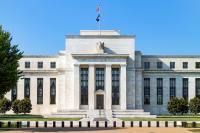
Didier Bouvignies, General Partner, CIO
Over the summer, the major global equity markets in the United States, Europe, and China rose steadily. France was the only real exception, once again penalised by its political situation.
In the United States, the publication of satisfactory growth indicators (retail sales, business confidence, growth of 3.3% on an annualised basis in the second quarter (1) boosted the markets during the summer period. At the same time, debates about the job market began to emerge following the sharp revision of job creation figures in recent months. Furthermore, rising inflation indices, particularly for producer prices, have not, at this stage, caused any major concern about consumer prices, despite the tariffs introduced by the Trump administration. In addition, the S&P 500 corporate earnings season has exceeded expectations, with a 10.5% increase compared to the 4% expected in the second quarter and more than 85% of positive surprises (2). Finally, the Fed now seems to be adopting a more accommodative stance, as evidenced by Jerome Powell's pivot in his speech at the Jackson Hole symposium on August 22.
At the same time, in Europe, the period was marked by a sharp upturn in business confidence in the manufacturing sector and core inflation (3) stabilising at 2.3% (4). This momentum now argues in favour of a pause by the ECB after eight successive rate cuts in fifteen months. On a more negative note, there were hopes, followed by disillusionment, regarding the peace agreement in Ukraine and the ratification, considered humiliating by many observers, of the agreement on customs duties with the United States at 15%, without any retaliatory measures being implemented. Finally, in China, economic figures remained disappointing, while the temporary 30% tariffs imposed by Donald Trump were extended pending the finalisation of an agreement.
During this period of relative calm, MIT threw a spanner in the works by questioning the profitability of massive investments in AI through a study highlighting that 95% of AI projects fail because they have no measurable impact on productivity or the Income statement (5). This adds to the turmoil following comments made on 18 August by Sam Altman, co-founder and CEO of OpenAI, about the potential development of a speculative bubble around the artificial intelligence sector, similar to the Internet bubble, and excessive investor optimism.
More broadly, several questions arise for the coming months. What will be the impact of tariffs on inflation, taking into account the delayed effects of massive stockpiling at the beginning of the year? Should we expect a temporary spike or a lasting trend? And who will foot the bill? The distribution between American companies, American consumers and foreign companies remains a matter of debate.
If the American consumers were the first to be affected by inflation, as observed historically and studied academically, two possibilities could be envisaged. The first would lead to a temporary spike without significantly affecting household purchasing power, allowing the Fed to continue lowering interest rates. This would be the most favourable scenario for the markets. The second possibility is more sustained inflation fueled by wage increases, in a context where unemployment remains low, particularly due to the new migration policy. Such a situation would hamper the Fed's actions, penalise asset values (equities and real estate) and probably justify an increase in household savings rates.
However, the valuation of the S&P 500, currently at 24 times expected earnings for 2025 and 22 times those of the next twelve months (2), reflects the particularly optimistic feeling of investors and the fading of fears about the economic cycle linked to Donald Trump's policies. A "Goldilocks (6) " scenario therefore currently seems to be preferred, inducing enough growth to improve the profitability of companies, without excess, to avoid rate hikes.
Europe remains cheaper and has several advantages. The recovery plans driven by German and European initiatives are encouraging the relocation of the region's abundant global savings. In addition, a slightly accommodative monetary policy and the observed decline in energy costs should also be supportive factors. However, two sources of concern remain: the strength of the euro and fears of a flood of Chinese products seeking new outlets in the face of Donald Trump's tariffs. It should also be noted that, while the eurozone's performance has caught up with that of the United States in euro over three years, this is the result of an appreciation in valuations in a context where corporate earnings have made little progress.
Another point of concern for the region is the political situation in France, even though its impact on European equity markets has been limited. The current climate, exacerbated by constant rhetoric of mistrust, is preventing voters from gaining a clear and objective view of the situation. Simplistic, even populist, solutions are frequently put forward to resolve the deficit and debt problem. In addition, successive governments have been talking about the bankruptcy of the French state for too long. Back in 2007, the Prime Minister at the time was already raising the issue with the public. At that time, debt represented 64% of France's GDP. Today, it stands at 114% (7). Talking about it for so many years without taking any real measures to curb it has undoubtedly led the French to no longer take the doom-mongering rhetoric seriously.
However, despite the high probability of the current government resigning on 8 September, the interest rate spread between France and Germany has not exceeded the peak of 88 basis points reached when the National Assembly was dissolved in June 2024 (2). There are two explanations for this. Although France's budgetary situation has deteriorated significantly, the current account balance, which represents the nation's total savings requirement, showed a slight surplus last year and has been negative by an average of 0.7% per annum since 2007 (8). Government deficits are offset by household savings, which represent nearly 19% of household income, 4 points more than before the Covid-19 epidemic (8). Secondly, this spread (9) relative to German debt implicitly reflects a three-notch downgrade of France's credit rating by the rating agencies. Its current borrowing rate is more in line with an A- rating, whereas it is rated AA-.
However, the situation is becoming increasingly tense because, unlike in 2010, France is now the worst performer in the eurozone. It has the highest public deficit with no clear prospect of improvement in the current political climate. This situation means that it currently borrows at one of the highest debt refinancing costs in the zone, close to Slovakia and Slovenia and slightly lower than Italy on 10-year maturities, but higher on 5-year maturities. Furthermore, this level of public deficit leads households to over save, a phenomenon known as the Ricardian effect, limiting the ability to allocate savings to growth-generating projects. However, unlike in 2011-2012, this situation has had little contagion effect on the eurozone as a whole. It remains specific to France, as countries such as Italy, Spain and Portugal have significantly improved their public finances in recent years. It is therefore likely, barring any major global events, that the markets will wait until 2027 to assess France's ability to meet its European commitments.
For more information, visit Rothschild & Co AM website.
(1) Source: U.S. Bureau of Labor Statistics, August 2025.
(2) Source: Bloomberg, 29/08/2025.
(3) Excluding food and energy.
(4) Source: Eurostat, August 2025.
(5) MIT NANDA, The GenAI Divide: State of AI in Business 2025, August 2025.
(6) An idyllic scenario.
(7) Source: Ministry of the Economy, Finance and Industrial and Digital Sovereignty, August 2025.
(8) Source: Banque de France, August 2025.
(9) The yield spread between a bond and a bond of equivalent maturity that is considered "risk-free".







